Cusco sits high in the Andes mountains of Peru, a charming city of tan adobe structures with red tiled roofs, old Spanish churches, winding cobblestone streets up steep hills. My traveling partner, my son Adam, and I met at the Lima airport in the middle of the night. I was coming from Guatemala where I was teaching, and he from Colorado during summer break from university. After a day of sightseeing in the city, we flew up to the high country. Lima’s cloudy skies were hazy white, but the Cusco sky mirrored the clear deep blue of Colorado mountain skies, as dazzling as the altitude. At 3,326 meters (10,900 ft), we took it easy the first few days to acclimate before strenuous hiking at even higher elevations.


Hotel Los Niños was started by a Dutch couple who adopted many Cusco street children. There are two clean and attractive hotels in Cusco that finance care of dozens of children, their medical and education expenses, and feed hundreds of local school children two meals a day and provide help with homework after school. The rooms are named for children—ours was named Luis. We had the pleasure to visit one of their living homes and meet several cheerful young students first hand. Niños Unidos Peruanos Foundation has since expanded to serve 600 children in Peruvian villages.


We missed the window to book an Inca Trail trek in advance, the reservation system had just started and was already a months-long wait. As in Antigua (Guatemala), however, the streets were lined with travel agencies anxious to sell you a trip that starts the next day. We booked a five-day trek by way of Salkantay Mountain, ending at Machu Picchu. Although there were not ruins dotting that trail, the scenery was spectacular, small villages appeared here and there, and it was undoubtedly a road less traveled. If I had seen pictures of some of the more difficult spots beforehand, I might well have chickened out—narrow rocky and eroding trails etched into mountainsides with precipitous drops. I gratefully accepted our guide’s steadying hand more than once. But it seemed like an opportunity not to be missed, and I found the courage to commit, taking things one step (literally) at a time.
Our last afternoon in Cusco, we chatted with a young man in the park. He taught us a few words in native Quechua, asked Adam about his interest in Cusco girls, and we compared life in the US and Peru.
“Remember the land of the poor when you are a professional,” he advised Adam when we parted.



The trek
We started our trek with a pre-dawn bus ride to the village of Mollepata, the jumping off point for the Salkantay trail. Elvis, our guide, introduced himself with the words “and I can sing too! Only kidding!” He gathered our small group for breakfast in a restaurant. Our trailmates were mostly European—a Belgian couple, an American/British couple (that we would later visit in London), a woman from Argentina, a German couple who discovered later that they were actually with another group but they joined us on the trail for part of each day. Johanna, a guide in training, joined us as well. After we secured our pack horses, Elvis grabbed my day pack, grinned, and said “I’m young.” I looked around and realized I was the oldest in the group. Armed with just my camera, I began walking.
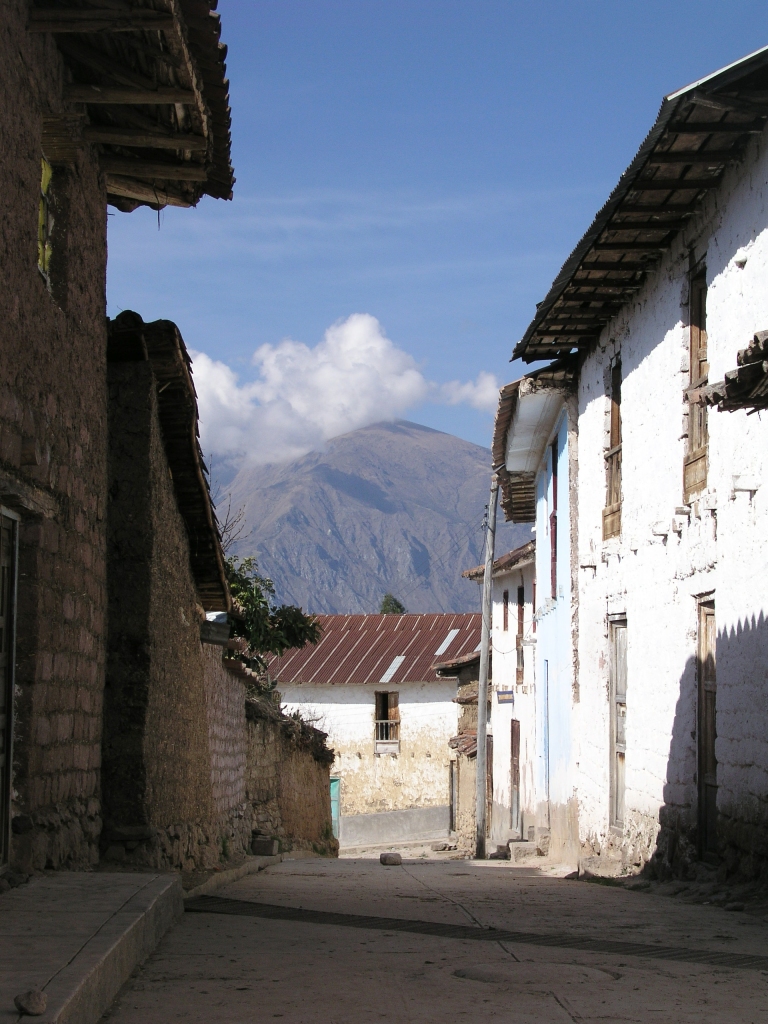
We climbed steadily the first day. Like Guatemalan volcano hikes, there were few switchbacks; the trails were steep and relentless. Elvis kept us entertained with details about the flora and stories from Inca lore of gods and battles and myths. We camped at the dramatic base of Salkantay (Goat Mountain) in the shadow of the 6,270 meter peak (20,565 ft), our coldest night. Our support team, four Peruvian men, had tents pitched and dinner cooking when we arrived. Three substantial meals a day kept our energy up, with cookies and popcorn to occupy us while cooking, delicious soups, a typical Peruvian main dish, and mate de coca or tea from coca leaves, which helps ward off altitude sickness.

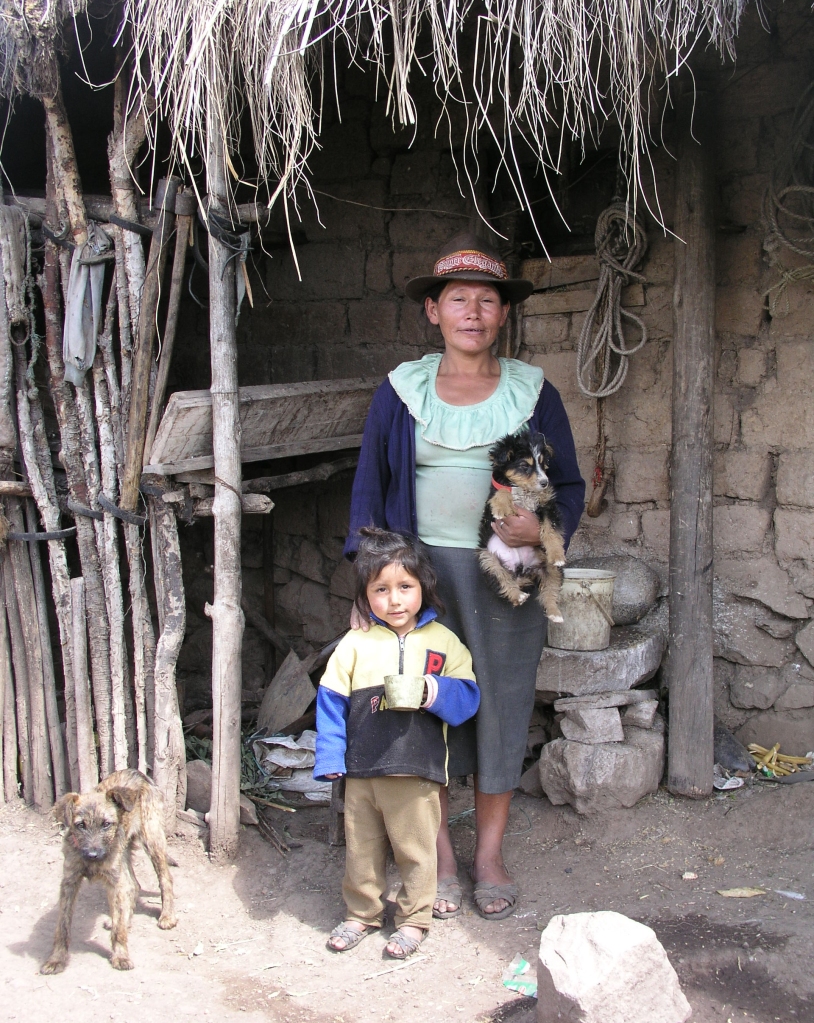

During dinner we talked about Peruvian and Argentinian politics. Conversation turned to the limits on the Inca Trail, which most of us had come expecting to hike. Treks must be booked at least thirty days in advance and the trail limited to five-hundred people per day including porters, guides, and cooks, limiting the number of tourists considerably and understandably helping to slow the damage to historic areas. The changes had been especially detrimental to small tour guide agencies and effectively closed them out of that trail. The larger companies mentioned in the guide books and on the Internet have better access to advance bookings and have larger support teams in their entourage.
Our most demanding day began with mate de coca delivered to our tents. The Germans appeared with packs ready to join us for the day’s trek. The towering white, rugged peak in the not-too-distant vista was ours to conquer. We hiked up the steep west shoulder in the snow. One of our party suffered from altitude sickness and needed a guide to lead and support her, another struggled with a pulled leg muscle. Blocking the snowy trail was a horse down with a hurt leg; the porters worked at moving his equipment to other animals and getting him on his feet. We had to break trail across the switchbacks through deep snow to get past.
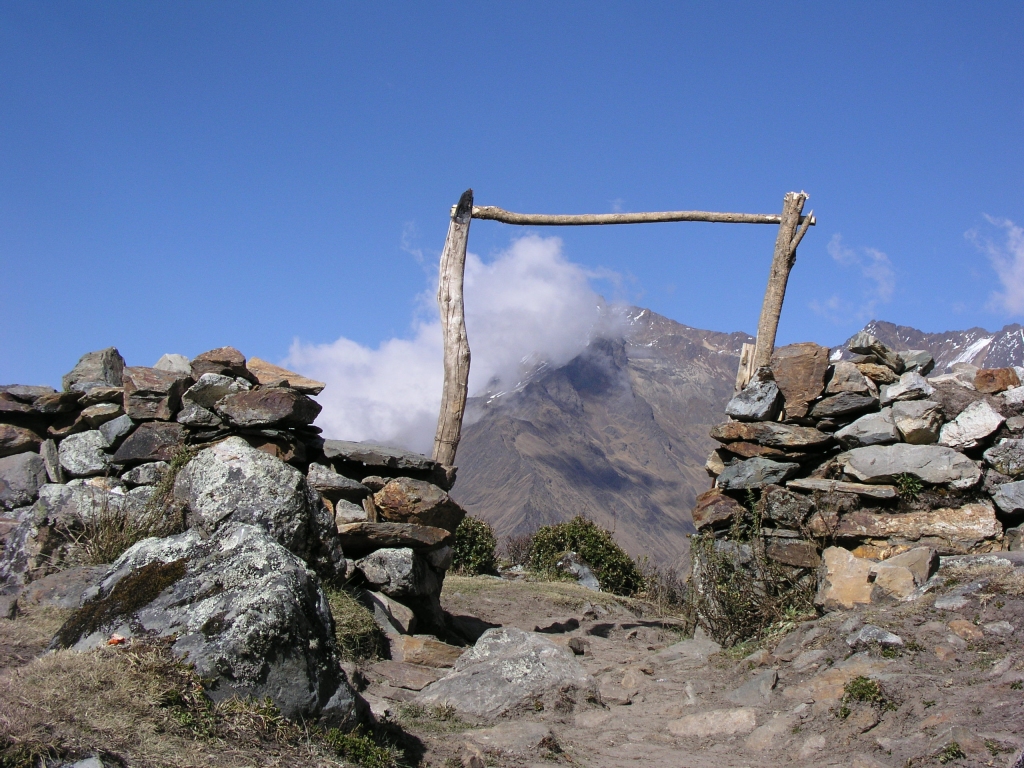


As we neared the last few turns in the trail, Elvis handed us each a rock to carry to the top, to ask the goat Salkantay for permission to cross. At the top of the pass (4,600 meters, 15,088 ft), amid misty snowflakes, were dozens of cairns, little rock piles that mark trails, sitting on top of larger rocks like so many offerings to an Inca god. We added our stones to the diminutive sculptures in the snowy mist. Elvis had us each throw a handful of coca leaves into the wind for luck on our journey.

The trail downhill was steep and sharp, we hiked on and on for two hours after dark until we reached the pampa, or meadow, filled with tents. Dinner conversation had a lighter note that night; we were exhausted but feeling good about having made it this far. Elvis and Johanna told folk tales of children kidnapped by dwarves, a dog in the form of a woman, and more, with strong morals.
Day Three took us through the village of La Playa along the Salkantay River, with a stop at a fruit stand selling grenadias that kept us eating the sweet yellow fruit for the rest of the hike. We reached a point beyond which the horses could not continue, so they headed back and four local porters, including two small women, carried our bags. Each was trained to carry up to fifty kilos (110 pounds), and made light of our load.
At one point we hopped a ride on a truck bed to Santa Elena. Railings outlined the back of the truck. Our friends draped themselves over and around every rail, hanging limbs bouncing over a bumpy dirt road ride along cliffs, called out to lower our heads when passing branches, and pointed out farms, “cafe!” “bananas!” “platano!” “palta!” (avocados), reaching out trying to grab fruit. There was a local party planned in the field where we were to camp, so we set up tents in a schoolyard. After a failed attempt at finding a trail to a hot springs, we dined late and several members of our group went in town to check out the party.
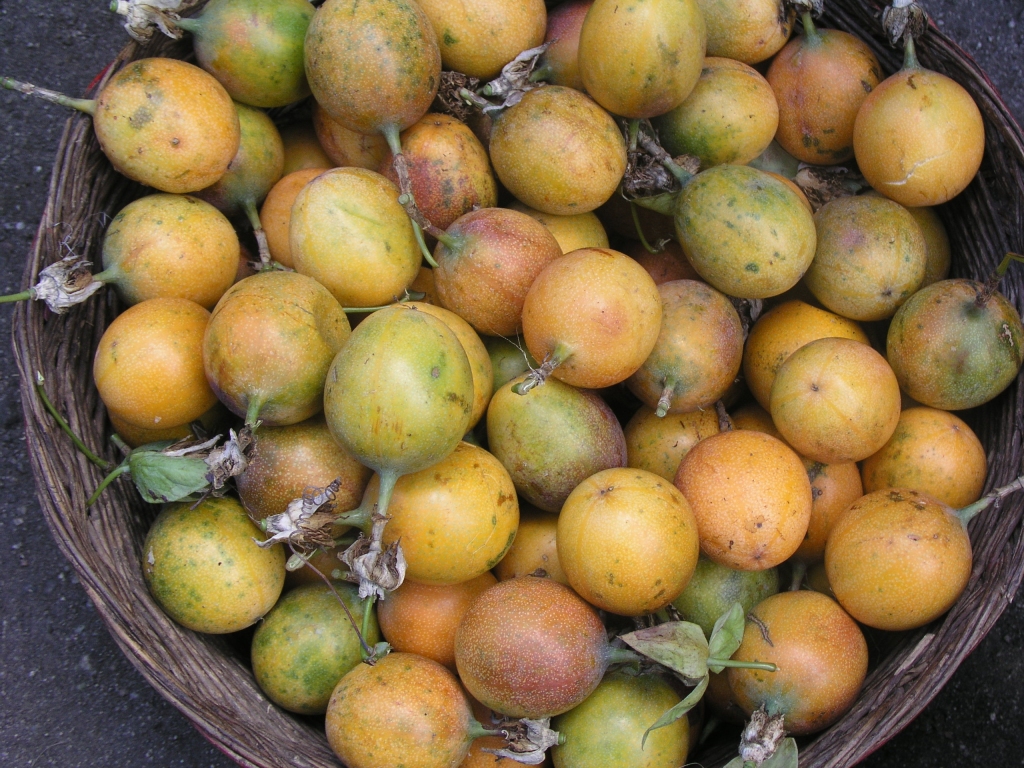

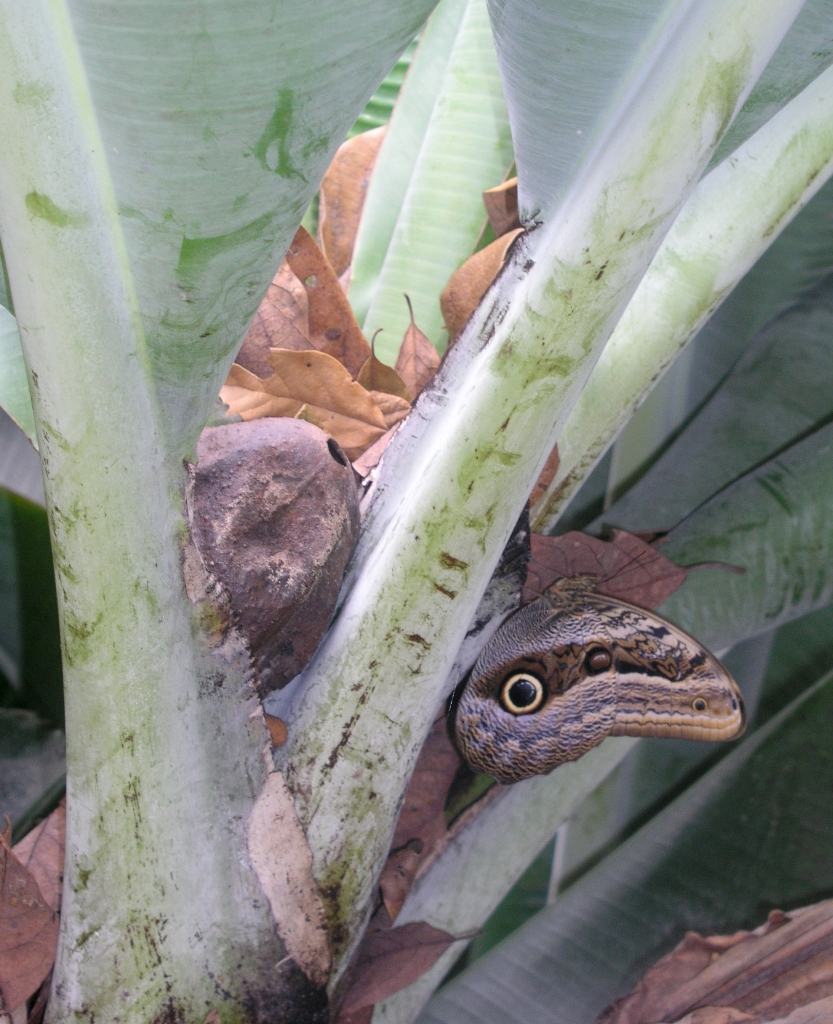
At breakfast we played a language game, naming things on the table in Spanish, each person repeating the list each time. The school children lined up to watch us take down the tents and hungrily gathered around to finish the remains on our breakfast table. When the bell rang, they ran in and we listened to their sweet voices singing the national anthem as the flag was raised.

That day we crossed the river in a tiny open cage way above white water. Two or three of us in the cage at a time, the first half of the ride was a slide down the cables to the middle of the river, then we were yanked across to the other side by a rope pull. There was no way around it; I had to cross. Without looking down, I climbed in and held on tight. Further up the trail we marveled at a powerful waterfall rushing out a hole in the rock under the road ledge, arriving there from some mysterious underground place. We were walking along a dirt road then, and a truck passed loaded with standing passengers; we waved to our German friends as they went by. The massive back of Machu Picchu rose in front of us as we approached, its treasures hidden from view, stalls lining the sides of the trail offering lunch.



Walking down the railroad tracks, we stopped at Mandor. Elvis negotiated with a woman who owned the land so we could enter. A cool, tranquil pool lay at the base of a tumbling waterfall. Some took a swim, others dipped our feet in, so refreshing, then walked back out to catch the train to Aguas Calientes (hot waters), the town closest to the ruins. We soaked our tired muscles in the natural hot springs pool and stayed in a hostel.


Watch for my next post: Machu Picchu and Inca ruins
Please do not download or reproduce images from this site. ©
Your comments are welcome!
Popular posts/stats/categories
Email me at: Ruth@RuthRosenfeld.com

I’d like to visit South America when it’s possible and definitely Peru. Thanks for sharing, have a good weekend.
LikeLiked by 1 person
Thanks for your visit! You as well.
LikeLiked by 1 person
What an interesting story, looking forward for what will follow.
LikeLiked by 1 person
Thanks so much, Rudi! I appreciate your comment. It was certainly an interesting journey.
LikeLike
Hope to get there someday – looking forward to your next post…..
LikeLiked by 1 person
Thanks, Marie for reading! We will be travelling again someday soon.
LikeLike
I have always wanted to see Machu Picchu but feel like I was along the trail . The photos are gorgeous, by the way 🙂
LikeLiked by 1 person
Thanks for coming along! and your kind comment.
LikeLiked by 1 person
🙂
LikeLike
Photos are so lovely, they really set the mood and transport one to Peru. Your article reminds me just how much I miss travel, the adventure of new and unfamiliar. I love the idea behind the hotel you stayed in. As always, thanks for sharing. Hope you are well.
LikeLiked by 1 person
Thanks so much! I often look for non-profits (NGOs) when I travel and have visited many. (Might be an interesting compilation some time…)
LikeLiked by 1 person
Wr hiked the Inca Trail a few years ago. Although we loved it, this trail seems to pass through more villages which is a nice option.
LikeLiked by 1 person
It wasn’t our first choice, but I was grateful it turned out that way – good friends, interesting less traveled trails, and a view of life in the little villages.
LikeLiked by 1 person
I liked the Salkantay trail bc there were less visitors. We didn’t see a soul. Not sure how it is now. Been 10 years!
LikeLike
I trekked the Inca Trail to Machu Pichu over 30 years ago. It was an amazing experience. The ruins along the route were very interesting but Machu Pichu is the crowning glory. Your photos are wonderful and I look forward to your next post.
LikeLiked by 1 person
Thank you! I wonder if there are any horse treks in the area?
LikeLiked by 1 person
I don’t know. I was not aware of any when I went in 1984. I am always worried about horse activities in countries where there is a lot of serious poverty as the owners may not be able to feed or look after the horses well enough. When I went to Peru I had been travelling in Chile and Argentina for two months before getting to Peru and Peru was by far the country with the most serious poverty. I hope perhaps it is better now.
LikeLiked by 1 person
A fabulous adventure. Doubt I will ever make it there. My son and his wife hiked the Inca trail in 2017, but ended up with a less than satisfactory tour provider. As Vegetarians, they did not eat well and ended up hiking a lot of the way in the rain. Still, they enjoyed the experience. Thanks for sharing. Allan
LikeLiked by 1 person
I don’t eat meat these days, actually I’m a pescatarian, seafood ok but mostly veggie. When I travel though I agree to eat what I’m served (within reason!). The tour guides and company can make a huge difference, I’m sure. Thanks for your comment, Allan.
LikeLiked by 1 person
I cannot wait for the next installment! What a magical adventure and you paint it so exquisitely through your words and photographs.
LikeLiked by 1 person
Thanks so much! It was a magical adventure… We were fortunate to have a great guide and an interesting group of people, besides the wonderful trek itself.
LikeLike
A spectacular area to have visited. Trips like this don’t happen every day.
LikeLiked by 1 person
That’s for sure! It’s one of my most memorable. Thanks for reading and commenting.
LikeLiked by 1 person
Loved our visit there.
That’s the street where we strolled while in Cusco. This brings back memories.
LikeLiked by 1 person
Thanks for reading and your own experience!
LikeLike
A fascinating trip and good to read as I don’t think I’ll ever go 😀
LikeLiked by 1 person
Thanks for reading and your comment!
LikeLike
🙂
LikeLike
I really enjoyed reading about your journey to Machu Picchu. I had the opportunity to do the shortened version of the Inca Trail hike which took just one day, but it was still probably the most physically draining activity I’ve done while travelling. That altitude is brutal! I would have loved to take a dip under the waterfall like in your photos.
LikeLiked by 1 person
Thank you! I didn’t know there was a one day trek. I imagine you had to cover a lot of ground, or left from a closer starting point. I live at 8,500 ft in Colorado and had just returned from visiting there so I was somewhat acclimated, but still, it’s a stretch!
LikeLiked by 1 person
Yes, the short Inca Trail starts from approximately where the 4 day trekkers would start on their final day, so it was about an 8 hour hike.
LikeLiked by 1 person
Sounds like quite the adventure! Not sure I could have handled crossing that river in a tiny cage!!
LikeLiked by 1 person
If I knew ahead of time, I might not have wanted to do it! Also there was another spot where a ledge cut into a sheer cliff. That was even worse! I was too shaken to take a photo.
LikeLiked by 1 person
What a thrilling adventure, Ruth! Congratulations on completing such a daring trip. Your images are wonderful- I am especially drawn to your portraits which show your connection to your subjects. Terrific post.
LikeLiked by 1 person
Thank you, Jane! I tend to be shy with portraits, I never do the real close-ups, not wanting to be intrusive.
LikeLiked by 1 person
I know the feeling, but you manage it well. I often shoot from the hip and look the other way. 😉
LikeLiked by 1 person
Must say a wonderful adventure! Stunning landscapes and lovely captures!
LikeLiked by 1 person
Thank you for coming with me! I appreciate your comment.
LikeLiked by 1 person
Exhilarating adventure. Thanks for the virtual travel , it’s the closest to traveling with the pandemic . Have an amazing 2021.
LikeLiked by 1 person
Thank you for coming along! I hope this year is a good one for you.
LikeLiked by 1 person
The Salkantay trail is beautiful! Nice write up. Brings back fond memories!
LikeLiked by 1 person
Thank you! And I will correct the spelling – I just did a search and see that.
LikeLiked by 1 person
I didn’t notice a mispelling?!? But that trail is great. Less trash and visitors than the Inca trail. And goes through prettier terrain.
LikeLiked by 1 person
The Salkantay route is tough enough when there isn’t snow on the peak! UGH! Slippery slopes make me nervous. Loved Cusco, thanks for sharing the adventure!
LikeLiked by 1 person
Thank you, Pam! It sounds like you’ve been there! It made me quite nervous as well. There were a few spots that were downright terrifying.
LikeLiked by 1 person
I like how descriptively you describe your trek. I felt like I was there peering over the “precipitous” drops with you. I especially got tickled that your guide was named Elvis 🤣.
LikeLiked by 1 person
Who would have thought the name Elvis would be found in Peru?! Thanks for reading and your comment on my writing. The description and personal stories are the fun part for me.
LikeLiked by 1 person
Quite an adventure with wonderful captures.
LikeLiked by 1 person
Thanks for visiting and your comment! It was an amazing trek.
LikeLiked by 1 person
wow love it.. 😉
LikeLiked by 1 person
Thanks for stopping by, Lisa!
LikeLiked by 1 person
The husband and I completed the 4 day Inca Trail Trek in 2017, and absolutely loved it. Though, I’m a little biased since he proposed on day 1 of the trek, so it had special meaning to me! Loved seeing your experience with the Salcantay Trek… it’s so different!
LikeLiked by 1 person
What a romantic trek that must have been! I’d love to have experienced the Inca Trail as well, but I know I won’t ever go back. Too many new places to explore. But no regrets, it was quite the adventure and a wonderful group of people, especially Elvis.
LikeLike
Although we have not hiked any trail, we have fond memories from Peru. Totally loved it!
xx
LikeLiked by 1 person